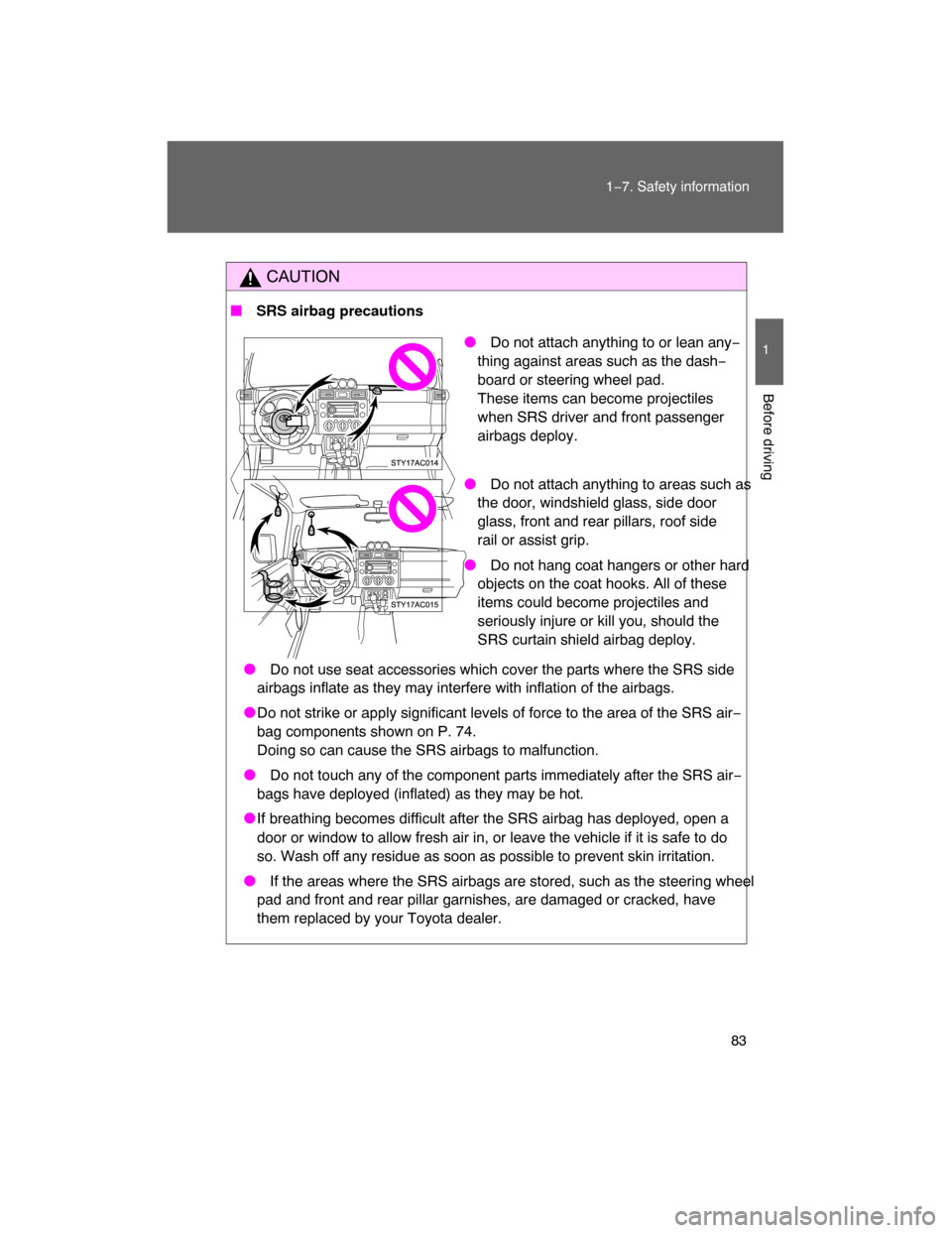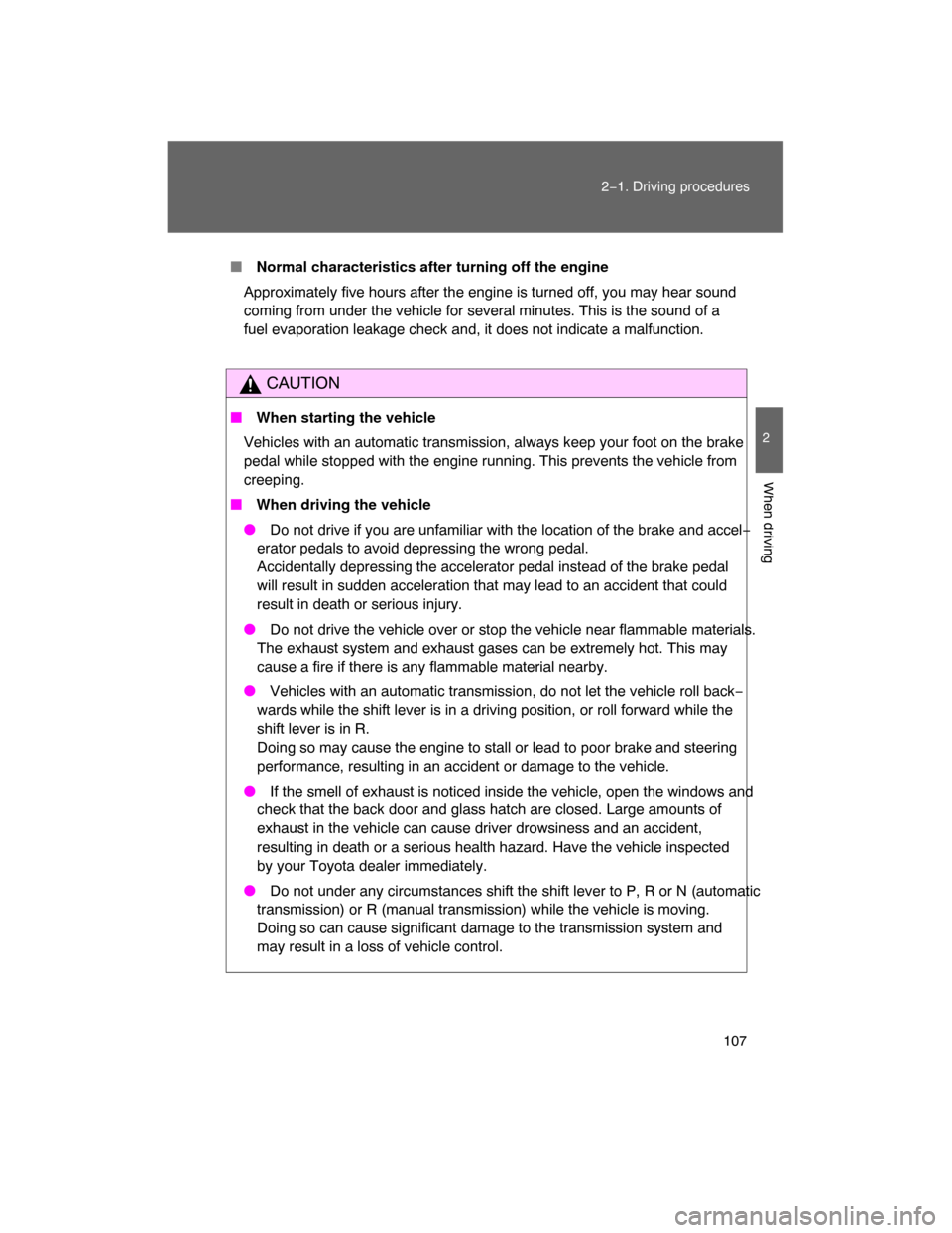Page 61 of 400
62
1−4. Opening and closing the windows
Power windows
Lock switch
Press the switch down to lock
passenger window switches.
Use this switch to prevent chil−
dren from accidentally opening or
closing a passenger window. The power windows can be opened/closed using the following
switches.
Driver ’s power window switches
Closing
Opening
One−touch opening (driver ’s
window only)
*
*:Pressing the switch in the
opposite direction will stop win−
dow travel partway.
Front passenger ’s power window switch
Closing
Opening
1
2
A
U
TO
Page 62 of 400
63
1−4. Opening and closing the windows
1
Before driving
� The power windows can be operated when
The engine switch is in the ON position.
�Operating the power windows after turning the engine switch off
The power windows can be operated for approximately 45 seconds even
after the engine switch is turned off. They cannot, however, be operated
once either front door is opened.
CAUTION
� Closing the windows
Observe the following precautions.
Failing to do so may result in death or serious injury.
� Check to make sure that all passengers do not have any part of their body
in a position where it could be caught when a window is being operated.
�
Do not allow children to operate the power windows.
Closing a power window on someone can cause serious injury, and in
some instances, even death.
Page 82 of 400

83
1−7. Safety information
1
Before driving
CAUTION
� SRS airbag precautions
� Do not use seat accessories which cover the parts where the SRS side
airbags inflate as they may interfere with inflation of the airbags.
�Do not strike or apply significant levels of force to the area of the SRS air−
bag components shown on P. 74.
Doing so can cause the SRS airbags to malfunction.
� Do not touch any of the component parts immediately after the SRS air−
bags have deployed (inflated) as they may be hot.
�If breathing becomes difficult after the SRS airbag has deployed, open a
door or window to allow fresh air in, or leave the vehicle if it is safe to do
so. Wash off any residue as soon as possible to prevent skin irritation.
� If the areas where the SRS airbags are stored, such as the steering wheel
pad and front and rear pillar garnishes, are damaged or cracked, have
them replaced by your Toyota dealer.
� Do not attach anything to or lean any−
thing against areas such as the dash−
board or steering wheel pad.
These items can become projectiles
when SRS driver and front passenger
airbags deploy.
� Do not attach anything to areas such as
the door, windshield glass, side door
glass, front and rear pillars, roof side
rail or assist grip.
� Do not hang coat hangers or other hard
objects on the coat hooks. All of these
items could become projectiles and
seriously injure or kill you, should the
SRS curtain shield airbag deploy.
Page 104 of 400

106 2−1. Driving procedures
Lightly depress the accelerator pedal at the same time as
gradually releasing the clutch pedal.
Release the parking brake.
� Driving in the rain
� Drive carefully when it is raining, because visibility will be reduced, the
windows may become fogged−up, and the road will be slippery.
�Drive carefully when it starts to rain, because the road surface will be
especially slippery.
� Refrain from high speeds when driving on an expressway in the rain,
because there may be a layer of water between the tires and the road
surface, preventing the steering and brakes from operating properly.
� Breaking in your new Toyota
To extend the life of the vehicle, the following precautions are recommended
to observe:
� For the first 200 miles (300 km):
Avoid sudden stops.
�For the first 500 miles (800 km):
Do not tow a trailer.
� For the first 1000 miles (1600 km):
�Do not drive at extremely high speeds.
�Avoid sudden acceleration.
�Do not drive continuously in the low gears.
�Do not drive at a constant speed for extended periods.
� Drum�in disc type parking brake system
Your vehicle has a drum−in−disc type parking brake system. This type of
brake system needs bedding−down of the brake shoes periodically or when−
ever the parking brake shoes and/or drum are replaced. Have your Toyota
dealer perform the bedding down.
� Operating your vehicle in a foreign country
Comply with the relevant vehicle registration laws and confirm the availability
of the correct fuel. (
P. 364)
Page 105 of 400

107
2−1. Driving procedures
2
When driving
� Normal characteristics after turning off the engine
Approximately five hours after the engine is turned off, you may hear sound
coming from under the vehicle for several minutes. This is the sound of a
fuel evaporation leakage check and, it does not indicate a malfunction.
CAUTION
� When starting the vehicle
Vehicles with an automatic transmission, always keep your foot on the brake
pedal while stopped with the engine running. This prevents the vehicle from
creeping.
� When driving the vehicle
� Do not drive if you are unfamiliar with the location of the brake and accel−
erator pedals to avoid depressing the wrong pedal.
Accidentally depressing the accelerator pedal instead of the brake pedal
will result in sudden acceleration that may lead to an accident that could
result in death or serious injury.
� Do not drive the vehicle over or stop the vehicle near flammable materials.
The exhaust system and exhaust gases can be extremely hot. This may
cause a fire if there is any flammable material nearby.
� Vehicles with an automatic transmission, do not let the vehicle roll back−
wards while the shift lever is in a driving position, or roll forward while the
shift lever is in R.
Doing so may cause the engine to stall or lead to poor brake and steering
performance, resulting in an accident or damage to the vehicle.
� If the smell of exhaust is noticed inside the vehicle, open the windows and
check that the back door and glass hatch are closed. Large amounts of
exhaust in the vehicle can cause driver drowsiness and an accident,
resulting in death or a serious health hazard. Have the vehicle inspected
by your Toyota dealer immediately.
� Do not under any circumstances shift the shift lever to P, R or N (automatic
transmission) or R (manual transmission) while the vehicle is moving.
Doing so can cause significant damage to the transmission system and
may result in a loss of vehicle control.
Page 133 of 400
135
2−3. Operating the lights and wipers
2
When driving
Rear window wiper and washer (if equipped)
� The rear window wiper and washer can be operated when
� The engine switch must be in the ON position.
�
The glass hatch is closed.
NOTICE
� When the rear window is dry
Do not use the wipers, as they may damage the rear window.
Intermittent window wiper
operation.
The wiper operates 3 times at
normal speed and then moves
to intermittent mode.
Normal window wiper oper−
ation
Washer/wiper dual opera−
tion
Washer/wiper dual opera−
tion
The rear window wiper oper−
ates while the washer squirts.
Page 167 of 400

169
2−5. Driving information
2
When driving
Winter driving tips
Carry out the necessary preparations and inspections before driving
the vehicle in winter. Always drive the vehicle in a manner appropri�
ate to the prevailing weather conditions.
� Pre�winter preparations
� Use fluids that are appropriate to the prevailing outside tem−
peratures.
�Engine oil
�Engine coolant
�Washer fluid
� Have a service technician inspect the level and specific grav−
ity of battery electrolyte.
�Have the vehicle fitted with four snow tires or purchase a set
of tire chains for the rear tires.
Ensure that all tires are the same size and brand, and that chains
match the size of the tires.
� Before driving the vehicle
Perform the following according to the driving conditions.
�
Do not try to forcibly open a window, scrape an outside rear
view mirror surface or move a wiper or outside rear view mir−
ror that is frozen. Pour warm water over the frozen area to
melt the ice. Wipe away the water immediately to prevent it
from freezing.
�To ensure proper operation of th e climate control system fan,
remove any snow that has accumulated on the air inlet vents
in front of the windshield.
�Remove any ice that has accumulated on the vehicle chassis.
�
Periodically check for and remo ve any excess ice or snow
that may have accumulated in the wheel well or on the
brakes.
Page 183 of 400
186 3−1. Using the air conditioning system and defogger
When the dial is set to , air
flows to the feet and the wind−
shield defogger operates.
The air intake selector is automat−
ically set to outside air mode.
To return the recirculated air
mode, press .
When the dial is set to , air
flows to the windshield and side
windows.
The air intake selector is automat−
ically set to outside air mode.
In this position, the air intake
selector cannot be changed to the
recirculated air mode.
� Switching between outside air and recirculated air modes
Press .
The mode switches between (outside air mode) and
(recirculated air mode) each time the switch is pressed.